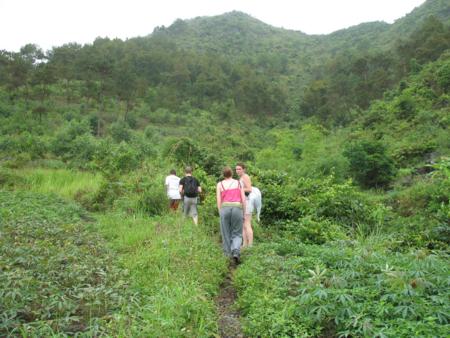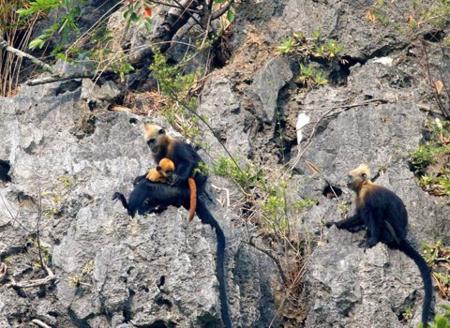Cat Ba is the largest of the 366 islands spanning 260km2 that comprise the Cat Ba Archipelago, which makes up the southeastern edge of Ha Long Bay in Northern Vietnam. Cat Ba island has a surface area of 285 km2 and maintains the dramatic and rugged features of Ha Long Bay. It is commonly used as an overnight hotel stop on tours to Ha Long Bay run by travel agents from Hanoi. This island belongs to Haiphong city – the most famous city of industry in Vietnam.
Cat Ba is the largest island in the Bay and approximately half of its area is covered by a National Park, which is home to the highly endangered Cat Ba Langur. The island has a wide variety of natural ecosystems, both marine and terrestrial, leading to incredibly high rates of biodiversity. Types of natural habitats found on Cat Ba Archipelago include limestone karsts, tropical limestone forests, coral reefs, mangrove and sea grass beds, lagoons, beaches, caves, and willow swamp forests. Cat Ba Island is one of the only populated islands in Ha Long Bay, with roughly 13,000 inhabitants living in six different communes, and 4,000 more inhabitants living on floating fishing villages off the coast. The large majority of the population can be found in Cat Ba town, which is located at the southern tip of the Island (15 km south of the national park) and is the commercial center on the Island. Since 1997, Cat Ba town has grown rapidly and has become a tourist hub for both the Island and greater Ha Long Bay. Especially, almost all surface of this island is deployed free wifi access points as well as 3.75 generation mobile networks, which can make visitors can easily work when traveling.
Tourism:
Today, Increases in infrastructure on the Island (including the building of bigger roads, dams to build harbors and to protect Cat Ba town from flooding, consistent electricity being brought to the island (which surprisingly happened as late as 1997) instead of having to rely on a generator, and large ferries and barges, able to transport trucks and cars to the Island from the mainland making daily trips to Cat Ba) made it easier for tourists to visit the Island, leading to a rapid increase in tourism and development in Cat Ba town starting in 2001. Since then, a stop on Cat Ba Island has been included in the itinerary of many Ha Long Bay cruises and a strip of tall, thin, five story budget hotels line the seafront, receiving more than 350,000 visitors a year. Currently, over 105 hotels are listed in Cat Ba Island’s tourist directory pamphlet, from cheap budget hotels to flashier upscale resorts, and construction is underway on many more. Right now, construction is under way on the colossal Cat Ba Amatina, an enormous project that will transform the southern coast of the island. The Amatina compound will be “a world-class integrated marina, casino, resort and theme park” spanning 171.57 hectacres and (VITC) will be able to host almost 6,000 residents at a time. The Amatina will boast “seven resorts with over 800 villas, three marinas, one international convention palace, 6 five star hotels and 1 four star hotel” (VITC). The scale of this project is gigantic and will basically create a luxurious mini-city on Cat Ba and will attract tourists from around the world. Cat Ba Island has become the adventure-tourism capital of Vietnam, and many of the activities advertised are nature-based. Visitors can kayak and take boat cruises through Ha Long Bay and the Cat Ba Archipelago, hike through the national park, mountain bike around the Island, spend time on Monkey Island just offshore, explore the Island’s many caves, swim on Cat Co 1, 2, or 3 (three sandy beaches a short walk from Cat Ba town), or even rock climb on the limestone karsts. With its stunning scenery, its association with Ha Long Bay, its proximity to highly populous cities like Haiphong (50 km) and Hanoi (150 km), and even China (many regional visitors come to the Island in the summer, the busy season, to avoid the heat and pollution in the cities), and plenty to do, Cat Ba Island has become a major travel destination for foreign and Vietnamese visitors alike.
The Cat Ba National park:
At the heart of Cat Ba Island lies a visually stunning and ecologically diverse national park. In 1986, 9,800 [98 km²] hectares (approximately one third of the Island’s total land mass) was annexed as Cat Ba National Park, the first decreed protected area in Vietnam to include a marine component (Dawkins 14). It had previously been the site of a timber company. In 2006, the boundaries of the national park were redefined, so the park contained 109 km² of land area and an additional 52 km² of inshore waters and mangrove covered tidal zones (langur website). The park is staffed by 92 people, including over 60 park rangers. In 2004, Cat Ba Archipelago was declared a UNESCO Man and Biosphere Reserve Area in order to protect the multiple terrestrial and aquatic ecosystems as well the diverse plant and animal life that is found on the Island. The UNESCO designation divides the archipelago into three distinct areas, each with certain functions and restrictions that regulates development and conservation measures on the Island: Core Area, Buffer Zone, Outer Transitional Area, Goals of the National Park, Biodiversity, The Cat Ba Langur.
How to get there?
The vast majority of people take a pre-booked tour from Hanoi on a tourist boat, though this is probably the slowest, least flexible and a relatively expensive way to visit Cat Ba and should be avoided at all costs unless you specifically want to be locked on a tourist boat for five hours while being given the hard sell and overcharged for the most minimal of refreshments.
It’s cheaper and more flexible to come either on a non tourist boat at Halong City or via Haiphong. If coming from Hanoi, you can also take a direct, combined bus/boat trip from Luong Yen Bus Station at 5:20, 7:20, 11:20 and 13:20 which takes 4.5 hours (compare: 5 hours for a slow tourist boat just to get from Halong City to Cat Ba’s northern port!) and costs 190,000 – 220,000 VND (US$9-$11) depending on season.
From Haiphong: there is a speed boat doing the trip several time a day (the last one around 16:00) from Ben Binh harbor. It costs 150,000 VND (May, 2012), read How to travel to Cat Ba island by motorcycle. Not more! The price is written on the ticket but some people sell false tickets with written 180,000 and they say the price was 150,000 last year or last month! If the boat arrive in Phu Long, they can also say that 180,000 include the bus from Phu Long to Cat Ba… but it’s also included in the 150,000 VND ticket: boat and bus can’t be divided… it’s the same company. See The bus stations in Hai Phong.


